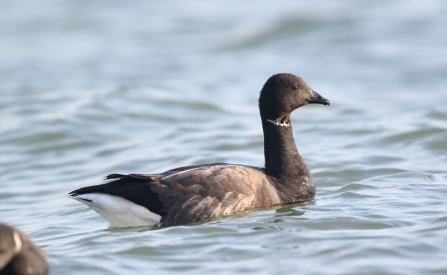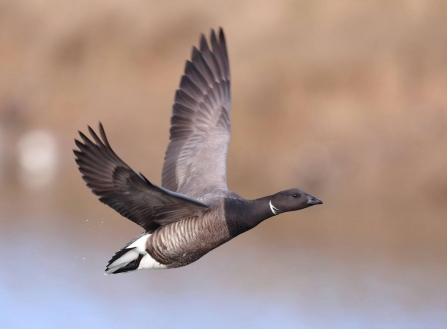There are several subspecies of Brent Goose; Pale-bellied, Black Brant and Dark-bellied, however, only the Dark-bellied Brent Geese winter here in Essex. They arrive on our shores in late October for a milder winter after travelling extraordinary distances of around 2,500 miles from their breeding grounds in the Taymyr peninsula in northern Siberia.
Species in the spotlight - Dark-bellied Brent Geese
Photo: Russell Savory

Photo: Andrew Armstrong
Dark-bellied Brent Geese are an unmistakeable black goose, they are strong and efficient flyers and our smallest visiting goose, around the size of a Mallard. They have a grey-brown back, a black neck and head and a white patch on their neck. Listen out for their loud “ronking” and “cronking” conversations as they feed or fly overhead.
The word Brent comes from the Anglo-Saxon word for burnt, which describes the colours of the bird’s plumage. The word Bernicula comes from the old belief that the birds turned into barnacles as historically, people didn’t realise that the geese migrated and seemed to simply disappear!
In Essex the geese first arrive in the river Thames where they feed on Eel grass before moving up the Crouch Estuary to graze on the grassy fields. The Crouch and Roach Estuaries combined support 2% of the UK population of Dark-bellied Brent geese and many winter further north in the sheltered Hamford Water National Nature Reserve. This means Essex’s estuaries are internationally important sites for these geese.

Photo: Andrew Armstrong
At our Blue House Farm nature reserve, around 2,000 Brent Geese gather in the fields to feed in the winter. It is at this site we have begun ringing the geese, in a joint partnership project with the Southern Colour Ringing Group. Last year, 18 birds were successfully ringed with a Darvic ring, allowing people to identify the individual goose by the ring’s unique letters. Individuals were then recorded in the Netherlands and the Baltics on their return to their breeding grounds.
This winter, whilst observing the geese through a spotting scope, Harry Smith, Essex Wildlife Trust’s warden at Blue House Farm spotted the first goose he had ever tagged in January 2017 return with a mate, this male had travelled over 5,000 miles since! Ringing allows important data to be collected on the birds about their migration patterns which can be used for important scientific data. This year at Blue House Farm the project will continue, hopefully gaining further detail on the geese’s stopover sites and local and lifetime movements.
Dark-bellied Brent Geese are classified in the UK as an Amber List species under the Birds of Conservation Concern review, due to the combined effects of hunting, food availability and condition and connection between migration stopover sites. Brent Geese, along with other migratory species, are strongly dependent on stopover sites to ‘refuel’ during their migration. At their breeding grounds their goslings are preyed upon by Arctic Foxes and Snowy Owls. The severity, however, depends on the Lemming population, if the Lemming population is low the predators tend to prey more heavily on the goslings.
Here in Essex, the geese are threatened by the loss and degradation of wetland habitats. At Essex Wildlife Trust’s Abbotts Hall Farm and Fingringhoe Wick nature reserves, the seawall was breached during a coastal realignment project in 2002. This converted arable farmland into saltmarsh and grassland to restore the UK’s rapidly declining coastal wetlands, a vital habitat for Brent Geese.
The geese will be leaving the shores of Essex in late March to return to their Arctic breeding grounds, so make sure you catch them before you go! Here are a few of our nature reserves where you may be able to see Brent Geese this winter:
- Abbotts Hall Farm – Great Wigborough
- Blue House Farm – North Fambridge
- Fingringhoe Wick Visitor Centre and nature reserve – Colchester
- Gunners Park and Shoebury Ranges nature reserve – Shoeburyness
- The Naze Centre – Walton-on-the-Naze
- Tollesbury Wick nature reserve – Tollesbury
- Two Tree Island – Leigh-on-Sea

